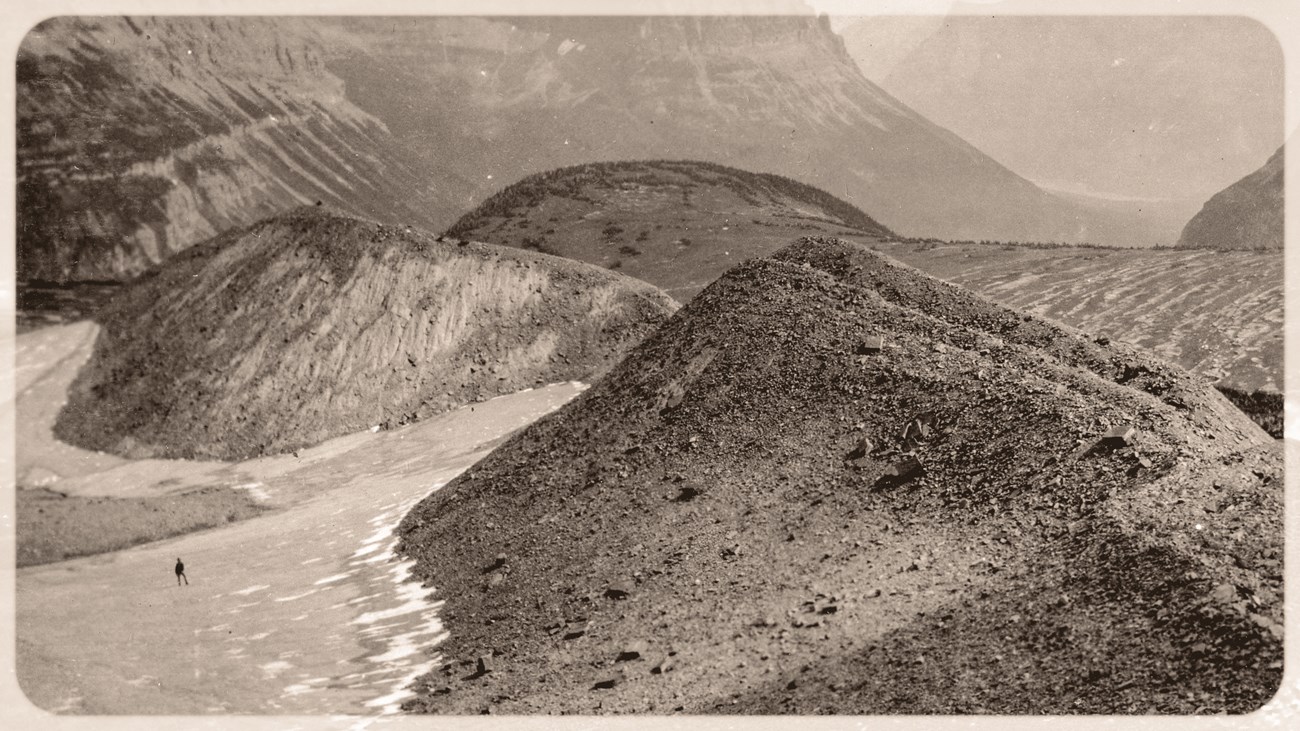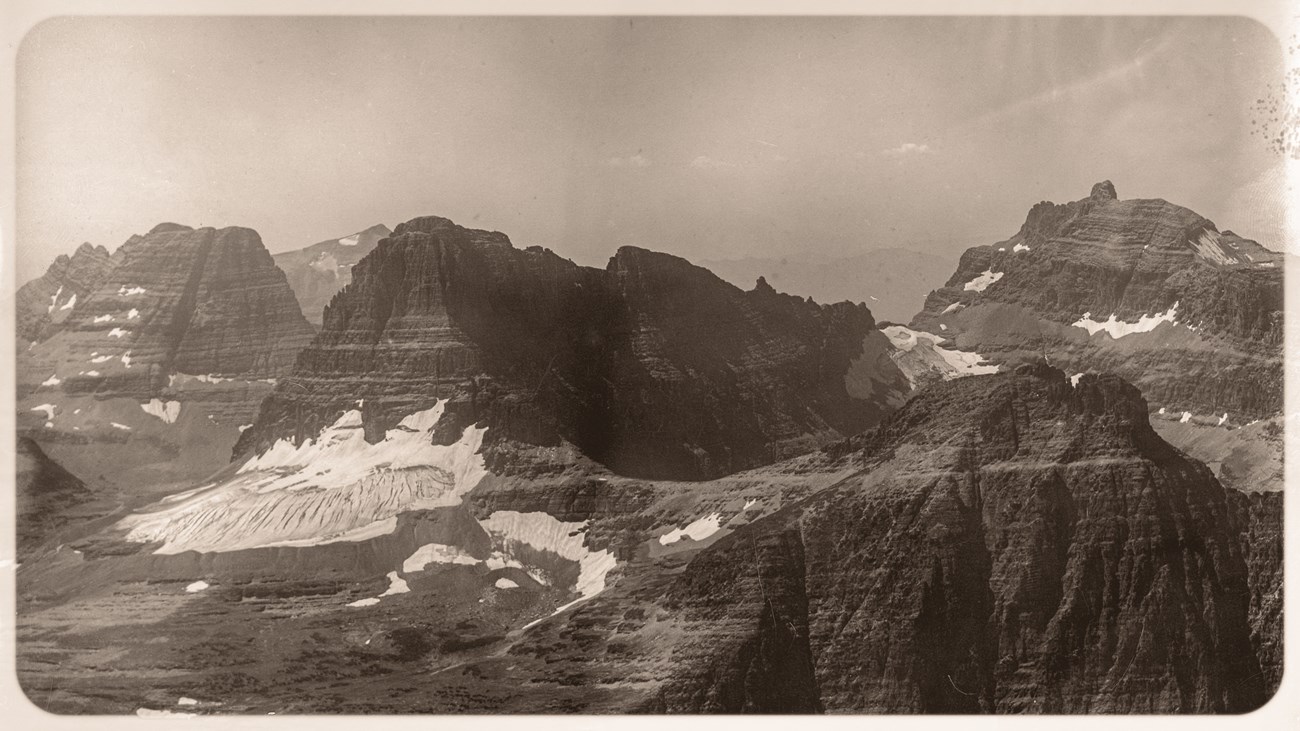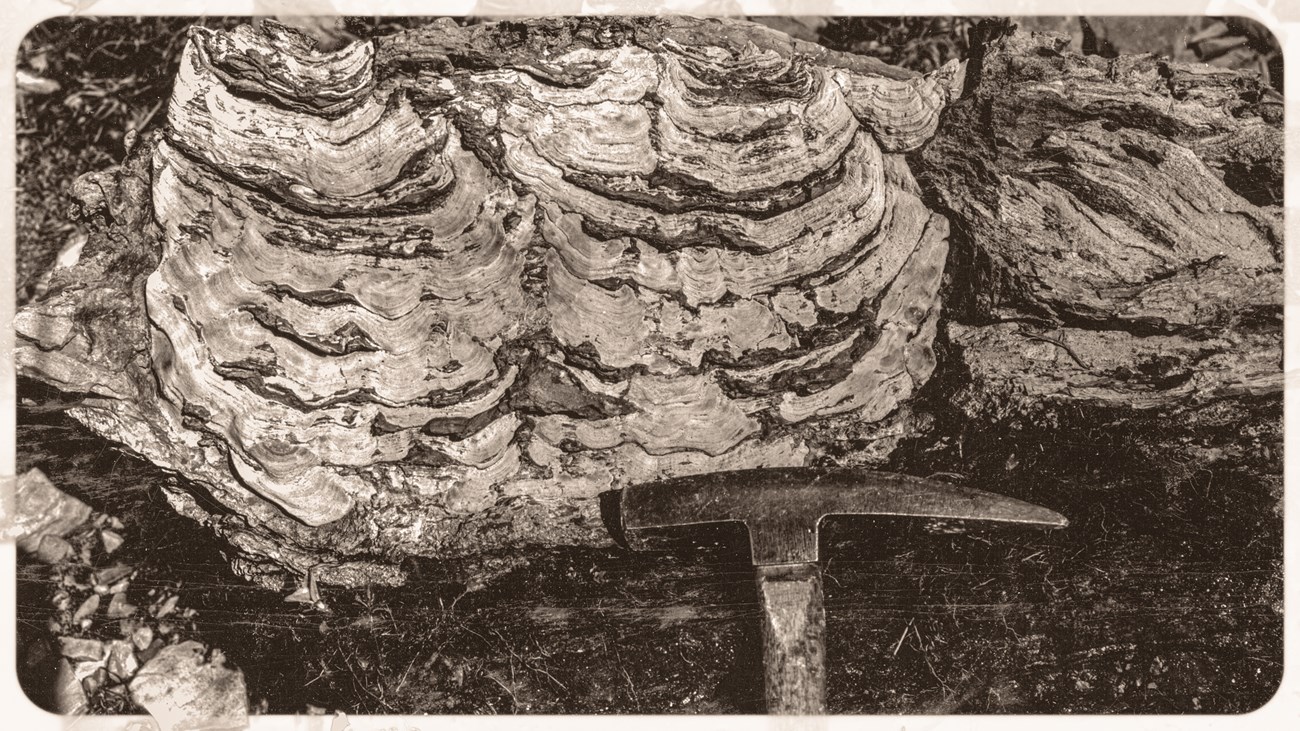Part of a series of articles titled Climate & History at Glacier National Park.
Article
Climate Change & Geologic History at Glacier National Park

This photograph of the Clements Glacier moraine at Logan Pass was taken in 1928 by W.C. Alden for the USGS.
Imagine a cold snap that lasts ten thousand winters.
When that happens, and more snow falls in the winters than can melt in the summers, you are probably in an ice age. For thousands of years this landscape has been shaped by the natural advance and retreat of colossal glaciers carving out the U-shaped valleys we admire today. For about 10,000 years now we have been in a warmer interglacial period.
If left to its own swings, our climate would be poised for another cold period soon (give or take a few thousand years) but human-caused climate change may have already postponed the next ice age.

The park’s current glaciers probably formed about 7,000 years ago and were at their largest size at the end of the Little Ice Age then started to retreat with the onset of a warming trend.
Logan Pass is an excellent place to get an up-close look at geologic evidence of the Little Ice Age, a cold period that lasted from roughly 1300 to 1850. The park’s current glaciers reached their largest size during that period.

Morton J. Elrod took this image of Clements Glacier (just left of center) in 1914.
The onset of a warming trend at the end of the 1800s melted many of this area’s smaller glaciers. Clements Glacier, shown here in 1914, was located near the modern-day trail to Hidden Lake Overlook.
Clements Glacier largely melted away at the end of the Little Ice Age, without much influence from modern climate change. Other glaciers in the park endured after the end of the Little Ice Age, though significantly smaller.
Some of the larger glaciers might have found equilibrium with the 21st century’s climate. Instead, human-caused climate change is melting them away.
While the decrease of glaciers since the end of the Little Ice Age is due to both natural and human-caused climate change, the retreat seen in recent decades can be increasingly attributed to anthropogenic causes. In this way, we have an opportunity to witness and study the power of climate change, both natural and not.
When you view Jackson Glacier from Going-to-the-Sun Road you stand in a valley carved by a Pleistocene glacier and see distant bedrock exposed as ice formed in the Little Ice Age retreats.
Glacier National Park has always been a place of change, and given time, it can adapt. However, the rate of change seen today is fast enough to raise concerns about adaptation, for both ecosystems and societies alike.

This simplified graphic was adapted from a paper published in Science by Marzeion and others in 2014.
Glacier National Park’s ice began to retreat after the peak of the Little Ice Age, in the mid-1800s. However, by the 1990s the majority of glacier retreat could be attributed to human-caused climate change. Glaciers melt when more snow melts in the summer than falls in the winter.

This picture, taken by Richard Rezak (USGS) in 1951, shows a geologist’s hammer resting on a stromatolite fossil.
Animals do the reverse: breathing in oxygen and releasing CO2. One organism you might not have heard of is responsible for the oxygen we breathe today: colonies of cyanobacteria (or blue-green algae) called stromatolites.
Ancient fossils of stromatolites are found throughout the park, including at Logan Pass. Through photosynthesis, they produced the oxygen in our atmosphere today—one tiny bubble at a time.
Burning fossil fuels, which releases many tons of CO2, has changed the composition of our atmosphere in under 200 years, while it took stromatolites over a billion.
The information in this article is featured in exhibits outside the Logan Pass Visitor Center. Check the exhibits out for yourself next time you visit!
“Neoglaciation in the northern Rocky Mountains, USA, began 5,300–7,000 years BP (Carrara 1989; Munroe et al. 2012) and reached its peak at the end of the Little Ice Age (LIA). The LIA was an anomalous cold period that lasted from approximately 1300 to 1850 in North America, and was likely triggered by volcanism (Miller et al. 2012),...”
“Initial glacier retreat has been attributed to recovery from the LIA, but Marzeion et al. (2014) provide documentation of increasing anthropogenic influence on glacier retreat in recent decades.”
Pederson, Gregory T., Daniel B. Fagre, Stephen T. Gray, and Lisa J. Graumlich. “Decadal-Scale Climate Drivers for Glacial Dynamics in Glacier National Park, Montana, USA: Drivers of Glacial Dynamics.” Geophysical Research Letters 31, no. 12 (June 17, 2004): n/a-n/a. https://doi.org/10.1029/2004GL019770.
Pp. 2. “From the mid-1940’s through the 1970’s retreat rates slowed substantially, and several modest advances were documented as the North Pacific transitioned to a cool phase. Relatively mild summer conditions also prevailed during this period. From the late 1970’s through the 1990’s instrumental records (Figure 4a) indicate a shift in the PDO back to warmer conditions resulting in continuous, moderate retreat of the Jackson and Agassiz glaciers.”
Alden, William C. Glaciers of Glacier National Park. United States Geological Survey, 1914. https://doi.org/10.3133/70200436.
Pp. 3. “Glacier National Park derives its name and much of its interest from the presence of many small glaciers
Marzeion, B., Cogley, J. G., Richter, K., & Parkes, D. (2014). Attribution of global glacier mass loss to anthropogenic and natural causes. Science, 345(6199), 919–921.https://doi.org/10.1126/science.1254702
Pp. 919. Writing about glacier retreat globally, “glacier response times are typically decades or longer, which implies that the present-day glacier retreat is a mixed response to past and current natural climate variability and current anthropogenic forcing. Here we show that only 25 ± 35% of the global glacier mass loss during the period from 1851 to 2010 is attributable to anthropogenic causes. Nevertheless, the anthropogenic signal is detectable with high confidence in glacier mass balance observations during 1991 to 2010, and the anthropogenic fraction of global glacier mass loss during that period has increased to 69 ± 24%.”
Pp. 921. “However, our results indicate that a considerable fraction of 20th-century glacier mass loss, and therefore also of observed sea level rise, was independent of anthropogenic climate forcing. At the same time, we find unambiguous evidence of anthropogenic glacier mass loss in recent decades.”
Florentine, C. (2019). Glacier Retreat in Glacier National Park, Montana (Fact Sheet No. 3068; p. 2). United States Geological Survey. https://doi.org/10.3133/fs20193068
Pp. 1. At the Last Glacial Maximum (approximately 20,000 years ago), GNP was almost entirely encased in ice, with glaciers filling mountain valleys and extending onto the plains (Carrara, 1989)
Alden, W. C. (1914). Glaciers of Glacier National Park. United States Geological Survey. https://doi.org/10.3133/70200436
Pp. 5. “Here what is left of the many snows of many winters has become compacted and changed to granular ice. When such ice accumulates to a sufficient thickness internal movement begins. Such moving ice constitutes a glacier.”
Carrara, Paul E. (1993). Glaciers and Glaciation in Glacier National Park, Montana (Open File Report 93-510 USGS-OFR-93-510; p. 18). United States Geological Survey. https://pubs.usgs.gov/of/1993/0510/report.pdf
Pp. 2. “Deglaciation of the Glacier National Park region is thought to have been completed more than 10,000 years ago.”
Grinspoon, David. Earth in Human Hands: Shaping our Planet’s Future. (New York: Grand Central Publishing, 2016)
Pp. 159. “The major beats occur at intervals of 23,000, 41,000 and 100,000 years. We call these the Milankovic cycles, after Milutin Milankovic, the Serbian astronomer and mathematician who is considered one of the founders of planetary climatology. In 1916, Milankovic published climate calculations of the surface temperatures on Mars, Venus, Mercury, and the Moon, some of which he had worked out while a prisoner of war during World War I.”
Pp. 162. “Even if we completely stopped spewing carbon next Thursday, it would take about one hundred thousand years for the natural carbon cycle to draw it back down to preindustrial levels. That’s probably long enough to delay the ending of the current interglacial and the onset of the next ice age.”
Pp. 167. “Is it possible that the most recent ice age may be the last one ever?”
Last updated: April 5, 2024
